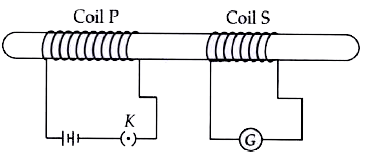Two coils of insulated copper wire are wound over a non-conducting cylinder as shown in the figure given below. Coil I has more number of turns than coil II.

What will happen if the current is passed continuously through coil I?
When current is passed continuously through coil I, the galvanometer will not show any deflection. There will be no change in magnetic field lines around the coil II. Thus, no induced current will be set up in coil II.
Topper's Solved these Questions
- EFFECTS OF ELECTRIC CURRENT BOOK - TARGET PUBLICATIONCHAPTER - EFFECTS OF ELECTRIC CURRENT EXERCISE - Practice Problems
24 Videos
- EFFECTS OF ELECTRIC CURRENT BOOK - TARGET PUBLICATIONCHAPTER - EFFECTS OF ELECTRIC CURRENT EXERCISE - Apply your Knowledge
52 Videos
- EFFECTS OF ELECTRIC CURRENT BOOK - TARGET PUBLICATIONCHAPTER - EFFECTS OF ELECTRIC CURRENT EXERCISE - Questions based on diagram
34 Videos
- DISASTER MANAGEMENTBOOK - TARGET PUBLICATIONCHAPTER - DISASTER MANAGEMENTEXERCISE - CHAPTER ASSESSMENT
2 Videos
- ENVIRONMENTAL MANAGEMENT BOOK - TARGET PUBLICATIONCHAPTER - ENVIRONMENTAL MANAGEMENT EXERCISE - APPLY OUR KNOWLEDGE
28 Videos
Similar Questions
Two coils of insulated copper wire are wound over a non-conducting cylinder as shown. Coil 1 has comparative large number of turns. State your observations, when

(i) Key K is closed. (ii) Key K is opened
Give reason for each of your observations.
View SolutionTwo coils A and B are wound on the same iron core as shown in figure. The number of turns in the coil A and B are NA and NB respectively. Identify the correct statement
View Solution
Knowledge Check
In the given diagram, two coils of insulated copper wire are wound over a nonconducting cylinder as shown. Coil P has larger number of turns.

Flemings right hand rule explains:ADirection of magnetic fieldBDirection of motion of conductorCOnly (a)DBoth (a) and (b)In the given diagram, two coils of insulated copper wire are wound over a nonconducting cylinder as shown. Coil P has larger number of turns.

In above phenomenon, the current is induced in another conductor,ABy changing magnetic fieldBBy increasing the strength of currentCBy decreasing the strength of the currentDBy using extra wireIn the given diagram, two coils of insulated copper wire are wound over a nonconducting cylinder as shown. Coil P has larger number of turns.

Which phenomenon is involved in it?AElectromagnetic inductionBMagnetismCElectromagnetismDNone of these
A coil of insulated copper wire is connected to a galvanometer. What would happen if a bar magnet is pushed into the coil?
View SolutionTwo coils of wires A and B are mutually at right angles to each other as shown in the figure. If the current in one coil is changed, then in the other coil

View SolutionA coil of insulated copper wire is connected to a galvanometer. What would happen if a bar magnet is held stationary inside the coil?
View SolutionIn the given diagram, two coils of insulated copper wire are wound over a nonconducting cylinder as shown. Coil P has larger number of turns.

The rule which helps us to know direction of induced current:
View SolutionIn the given diagram, two coils of insulated copper wire are wound over a nonconducting cylinder as shown. Coil P has larger number of turns.

A momentary deflection is shown by the galvanometer , when:
View Solution
